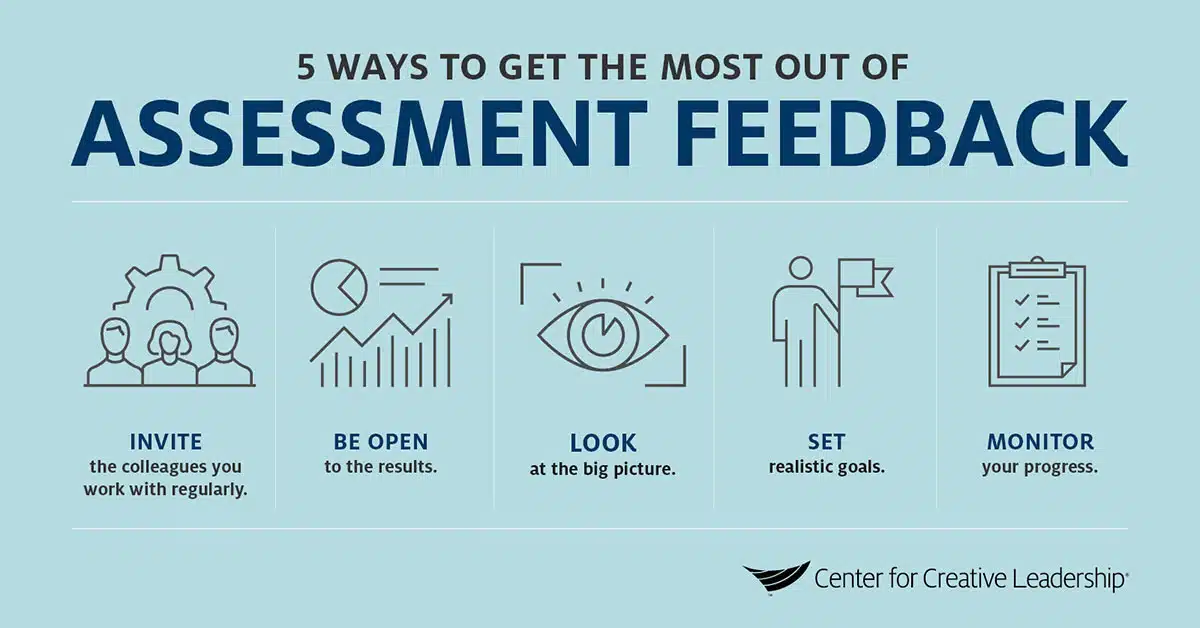Why do so many executive education, leadership development, and talent retention programs start with feedback surveys such as 360 assessments? Because they’re a great way to make certain that leaders focus on honing what matters the most.
But what’s the best way to approach the feedback you get from your 360 assessments? The key is to get the right feedback from the right people and to use it in the right way.
The Best Way to Get and Use Assessment Feedback
5 Steps to Leverage Your Assessment Feedback
Here are the 5 steps we recommend to get the most from your assessment feedback:
1. Invite the right people to give assessment feedback.
The most useful feedback will come from whomever you work with most closely. They don’t have to be dear friends or even people you like. Just look for colleagues who are in the best possible position to observe your behavior on a frequent basis.
Explain what you’re doing and ask for their help. Encourage them to be direct and honest in their responses when the survey arrives. This personal outreach will increase your response rate and invite the kind of helpful, actionable feedback you need.
2. Be open to the results.
Be ready to embrace your assessment feedback and whatever it contains. Don’t discount positive results or become defensive about the negative. Remember that your survey participants have done precisely what you asked them to do. Be open to what they tell you, and then use it to jumpstart your personal and professional development.
3. Look at the big picture.
Identify overarching themes and patterns in your assessment feedback report, instead of latching onto any single data point. If you become overly focused on certain responses, you may miss the bigger picture. So sit with your results and mull them over. Give yourself some time to reflect. Work with a coach to pull the pieces together and to frame key insights you can take away and use as a touchstone.
4. Use what you learn to set realistic goals.
When it comes to leadership development, one size doesn’t fit all. You need a plan that responds to your own individual needs — and that’s where assessments shine. They help you understand your impact on others and crystallize what it means for you to become a more effective leader.
You see which leadership competencies are already strengths and where you have gaps that need work. Use those “big picture” themes you’ve uncovered in Step 3, and think through the areas you’re most motivated to change. Set achievable goals and use what you’ve learned to build your leadership development roadmap.
5. Monitor your progress.
Share your development plan with your boss and with other trusted colleagues who are committed to your success. Ask them to support you and to help you stay on track and turn your intentions into reality. Check in with them at regular intervals to discuss your progress and to evaluate how the changes you’ve made are being received.
You can use what you learn to fine-tune your approach and further accelerate your leadership development — and your career.
In combination, these steps will help you get the most from assessment feedback.
Assessment Feedback Can Provide a Wake-up Call
For example, consider the experiences of a chief policymaker in the healthcare field, who we’ll call “Ellen.”
When Ellen enrolled in one of our development programs for senior executives, her workplace colleagues gave her 360 assessment feedback on her leadership capabilities.
And the results caught her by surprise as she realized what her 360 results meant. While she got rave reviews from bosses and direct reports, her peers on the executive team gave her uniformly low marks. She discovered they saw her as someone focused only on herself, with little interest in the challenges they faced. It was a real wake-up call and became a focal point for the leadership development work Ellen needed to do.
She synthesized the assessment feedback from her raters and determined what steps she needed to take next. Rather than spending time on things she was already doing well, she concentrated on building better communication with her peers. She tried making herself more available to her colleagues and expressing an interest in and support for their work.
The results were transformative. The entire executive team began to collaborate more effectively together on important policy issues. Ellen and her colleagues found a new sense of satisfaction and enjoyment in their work, energizing the entire workplace.
The insights she gained from her 360 assessment feedback data, combined with the tailored recommendations for action steps she received, accelerated Ellen’s leadership development in a meaningful way — and it can do the same for you.
Ready to Take the Next Step?
It’s important for leaders to understand how their peers and direct reports perceive them in order to lead most effectively. Assessment feedback can help. Learn more about our 360 leadership assessment feedback solutions, and take your organization’s leadership to the next level.








